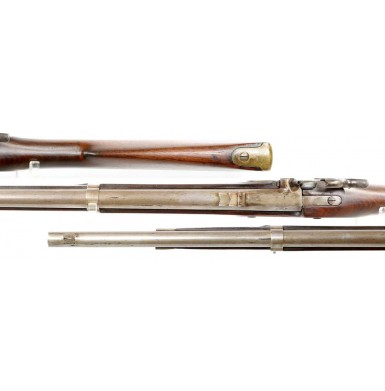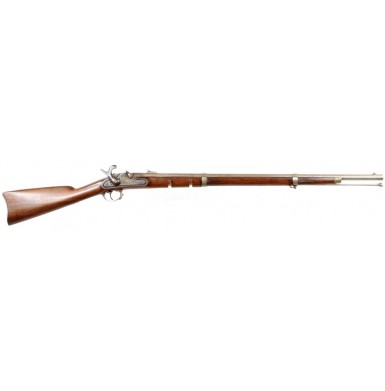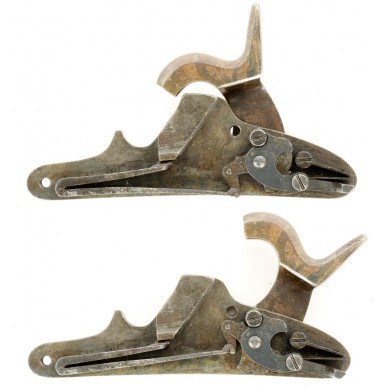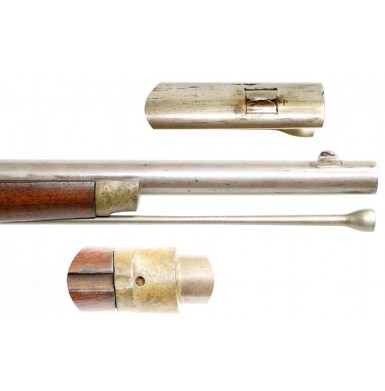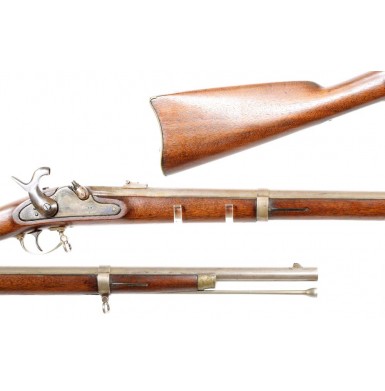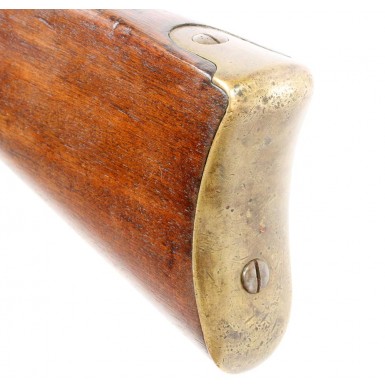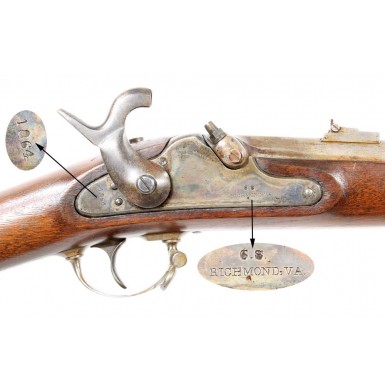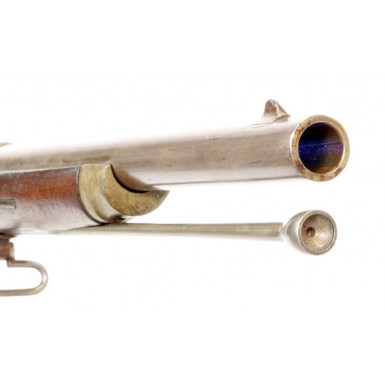The story of the Richmond Armory during the American Civil War is well known and there is no need to go into a lengthy description of its Civil War operations. For those less familiar with the Richmond Armory, a brief recap of its pre-Civil War history is provided. The armory was originally established by an act of the Virginia legislature in 1797. The Virginia Manufactory of Arms, as it was originally known, was located along the James River in Richmond. Its intended purpose was to supply the Virginia militia with the required arms for the defense of the Commonwealth. Over a roughly two-decade period, from 1802 through 1821, the Virginia Manufactory produced a variety of small arms, including some 58,000 flintlock muskets, 4,000 flintlock pistols, 2,000 flintlock rifles, and some 10,000 sabers. The facility also produced about 300 canons during this period. Although the facility was shut down circa 1821, primarily because arms were forthcoming from the US government under the Militia Act of 1808, it was resurrected immediately prior to the Civil War as the Richmond Manufactory of Arms. In the interim the facility served as an arsenal (storage facility), rather than an armory (manufactory). In 1860, with the clouds of war looming, the Commonwealth decided to return the facility to its prior manufacturing status. To perform this task, former Harpers Ferry Master Armorer James Burton was hired to set up the facility. Burton had just returned from overseeing the set-up of the British Royal Small Arms Factory (RSAF) at Enfield Lock, Great Britain's version of the "Springfield Armory" and was undertaking to receive the necessary machinery to manufacture rifle muskets in Richmond when the Civil War erupted. On April 17, 1861 Virginia voted to secede from the Union, and the following day the Union forces at Harpers Ferry set fire to the armory in an attempt to destroy the stores of arms, parts of arms and machinery. The efforts had limited effect. Virginia Captain Turner Ashby arrived a couple of hours after the fires were started and his troopers, and with the assistance of the townspeople of Harpers Ferry put out the fires. Most of the townspeople were more motivated by the fear the fires would spread through the town and destroy their homes and businesses than by any commitment to particular cause. By April 27, 1861, Virginia Colonel Thomas "Stonewall" Jackson had arrived to take charge of the facility, its inventory and machinery. Jackson oversaw the shipment of the armories inventory and equipment to Richmond. There, the rifle musket making machinery and the store of rifle musket parts (both finished and unfinished), and related raw materials formed the basis for a new manufactory to produce rifle muskets for the Confederacy. The machinery from the Harpers Ferry Rifle Works was sent further south to Fayetteville, NC where the Confederate Fayetteville Armory would be established. Former Harpers Ferry Master Armorer James Burton oversaw the rebirth of the Virginia Manufactory as the Richmond Armory and remained in charge there until the summer of 1862, when he was transferred to Macon, GA to establish that armory. Captain Sloan was Burton's initial replacement, who was in turn replaced by Captain Downer, who would run the Richmond Armory for most of the remainder of the war. During the course of the war the Richmond Armory's primary production would include 40" barreled rifle muskets, 25" barreled carbines, and a small number of 33" barreled rifles, along with a similarly small number of 1842 pattern .69 smoothbore arms. All were percussion muzzle loading firearms, and with the exception of slightly less than 1,800 .69 M1842 pattern muskets and musketoons, all were nominally .577 / .58 caliber and were simplified versions of the US M1855 Rifle Musket. The primary changes were the elimination of the Maynard automated tape priming system in the lock, the use of brass for the buttplate and nose cap, and the adoption of a straight-shank ramrod instead of the swelled shank rod used on the US M1855 and M1861 Rifle Muskets. The ramrod spoon was also eliminated from the stock, to make the machining of the wood easier and to save production time as well. The Richmond Armory was set up and producing complete rifle muskets by the fall of 1861, primarily assembling them from captured parts on hand, turning out about 2,300 new rifle muskets during the last quarter of 1861. The following year the armory would turn out approximately 9,000 new rifle muskets, with roughly 13,000 produced in 1863, about 6,300 in 1864 and slightly less than 400 in 1865. In all, the Richmond Armory manufactured roughly 31,000 rifle muskets during the course of the war. The armory would also produce some 5,400 rifled carbines and about 1,300 33" barreled rifles.
From the outset, one of the biggest problems for the armory was the procurement of enough stocks. After using the supply left over from Harpers Ferry, the problem became more acute until the stock making factory at Macon was starting to deliver stocks in the fall of 1862. The Macon manufactory soon ran into a problem securing sufficient supplies of black walnut suitable or stocks, and the final deliveries to Richmond were made in March of 1864, with no further deliveries being made. The last of the stocks were used by December of 1864, and as a result no further deliveries of rifle muskets were made by the Richmond Armory after January of 1865. With the acute shortage of stocks becoming a serious problem by mid-1864, the armory started to focus on repairing rifle muskets rather than making new ones; a job that had previously been a secondary goal for the armory, with the Richmond Artillery Workshop handling much of the repair work prior to that date. Other shortages, including a lack of useable barrels, resulted in some arms being deliberately manufactured with "old barrels", particularly Richmond carbines, of which some 500-600 were manufactured during 1863 using "old barrels". These shortages were the motivation to start producing the 33" barreled rifle. From the outset these guns were made with the classic Richmond "pinched" front sight as used on the carbines and could not accept any form of bayonet. Its length was equally handy for use by either cavalry or infantry. The first 261 rifles were made using "old parts" in June of 1864 with an additional 200 produced from "old parts" the following month. Those first 261 rifles were issued to 5th and 15th Virginia Cavalry that summer, as no carbines were readily available. An additional 850 rifles were produced in three batches between September 1864 and January 1865. The arsenal also regularly used salvaged and scavenged parts from US rifle muskets, including (but not limited to) locks, stocks, barrels barrel bands, miscellaneous furniture, rear sights, and ramrods. The use of various reclaimed US rifle muskets parts during the period of production means that "pure" Richmond Rifle Muskets are rather scarce, as it was not uncommon for any gun coming out of the armory to have at least some reused small (or even large) parts. When repairs performed during the war at the armory and post-war repairs and replacement parts are considered, a truly pure, 100% Richmond Rifle Musket becomes an incredibly rare item. As a result, nearly every Richmond Rifle Musket on the market today is a composite piece, that could well be 100% period, but is rarely 100% Richmond made parts. The difficulty is trying to determine the period when the parts were assembled, and to find the dealer who will honestly reveal what the configuration of the gun really is; and just how much of it is in fact "Richmond made."
Offered here is a FINE condition Richmond Rifle. As a Confederate arm, the condition is so good that it would really be called "Very Fine", when compared to most Confederate long arms on the market. The rifle, like many Richmond produced arms, is a partially composite gun. In my opinion, the gun is one of the 461 Richmond Rifles made from "old parts" that were delivered by the arsenal in June and July of 1864. Most of these rifles from "old parts" appear to have been US rifle muskets that had been shortened to rifle length and repaired to put them back in action. This gun is primarily assembled from Richmond produced components, so it may have been considered one of the 850 "new" rifles that were produced, but in my opinion could have been made from a damaged Richmond rifle musket; thus, qualifying as a gun from "old parts". The guns that were newly made were delivered in September and November of 1864 and January of 1865, with the deliveries amounting to 420, 200 and 230 in each month, respectively. After disassembling the gun, I believe the origin of the parts that make it up to be as follows: the lock, stock, barrel, buttplate, nose cap, front sight and possibly the ramrod are of Richmond origin. The rear sight, barrel bands and the triggerguard and trigger assembly are likely from US muskets that were recovered on the field. In my opinion, the barrel and stock were shortened from original Richmond rifle musket parts. However, it is not clear if this was done to use parts that were otherwise new but not usable in a rifle musket due to quality issues, or if the parts were from a damaged Richmond rifle musket. In either case, with only a total of 1,311 Richmond 33" rifles produced, this is one of the rarest of the arms to be produced at the Richmond Armory.
As previously noted, the condition of this Richmond Rifle is about FINE. The low hump Richmond lock is clearly marked C.S / RICHMOND, VA. in two horizontal lines forward of the hammer and is dated 1864 vertically behind the hammer. The "8" in the date is correctly lacking the middle line that separates the upper and lower lobes of the number, as shown on page 216 of Paul Davies' definitive book on the subject: C.S. Armory Richmond. The interior of the lock shows the rough finishing and file marks that are typical of Richmond produced locks. It has the correct 1855 pattern short upper arm mainspring, as well as the correct 1861 style stirrup (swivel) that was adopted at the Richmond Arsenal during 1863, replacing the more triangularly shaped 1855 swivel used prior to that time. The lock is in fantastic condition, retaining about 60%+ of its original vivid casehardened finish on the exterior. Like US locks of the period, the locks made at Richmond were casehardened to properly heat treat the metal. This resulted in mottle colors on the lock, which were then polished off while finishing the lock, creating the "National Armory Bright" finish that we are familiar with. During 1863 and 1864 the US arsenal at Springfield experimented with leaving some locks with their casehardened finish and not polishing them to bright. Richmond sometimes left the locks unpolished as well, most likely as a time saving expedient. This is most often encountered on early war Richmond locks on particularly fine condition arms that saw little use. This is the first time that I have encountered an 1864 dated lock with the casehardened finish intact, but it is absolutely original and correct. The breech of the barrel is not date, but the left angled flat retains a clear set of standard proof marks, including the expected V / P / (Eagle Head). The brass buttplate is a classic example of a cast Richmond buttplate, and the brass stock cap is classic Richmond production as well. It is secured to the stock by a single iron screw, typical of post-February 1862 production Richmond rifle muskets. The nose cap is only slightly relieved in order to apply tension to the ramrod, as no spoon was included in the stock. The lock is mostly smooth, with only some lightly scattered surface oxidation and pinpricking present, as well as some small areas of minor light pitting. The lock also shows traces of old dried oil or grease that has left a brownish color over some of the lock. The lock remains fully functional and operates crisply on all positions. The 33" barrel appears to have been cleaned and shows numerous flaws in it that are visible as small fissures in the metal. The crevices of these flaws show deep oxidation, and remnants of old rust. There is some old rust and oxidation in the steady pin notch for the rear sight as well. It is not clear if the barrel was cleaned during modern times or if it was cleaned prior to being assembled into this rifle, as part of the rehabilitation of the Richmond rifle musket to make it a useable rifle barrel. The barrel has a thin, lightly oxidized brown patina, as well as some lightly scattered pitting. The iron breech plug is slightly crude and is certainly of the period but may have been part of the repair and refitting process as well. Amazingly the bore of the rifle remains in about FINE condition. The bore is mostly bright with fine, crisp rifling along its entire length. The condition of the bore matches the condition of the lock very well. Showing some use, but not heavy use or any signs of abuse. The barrel extends 5 3/8" from the end of the stock, correct for a Richmond rifle. The rear sight is a correct, period 1858 pattern rear sight that is probably US produced piece, as the serifs on the numbers "3" and "5" are not as bulbous as those typically applied at the Richmond Arsenal. The front sight is the typical Richmond production "pinched" front sight and is located 7/8" from the muzzle. The ramrod is a correct pattern straight-shank tulip head rod that remains in fine condition as well. The rod is full-length and retains threads on the end. The threads seem a little small, but I did not have any Richmond produced implements to try on the end. The original period sling swivels are present on the front bow of the triggerguard and on the upper barrel band. The bands are probably reused US bands, as the "U" marks are not as off-set as those typically identified as "Richmond made", but the "U" on the lower band appears to have been struck more than once, so that lack of quality control may indicate it is of southern origin. Like the barrel, the bands have been cleaned, with the upper band in particular showing dark oxidation on the bottom around the swivel stud and on its interior. The cast Richmond brass buttplate has a lovely, deep ocher patina that is untouched and uncleaned. The nose cap has a similar patina, and shows rough, sand casting with minimal polishing. The stock of the musket is in about FINE overall condition and is a particularly crisp and attractive Richmond Armory stock. The stock is solid, complete and full-length. It also is free of any breaks or repairs. The stock remains very crisp and retains strong lines and edges, with no indication of having been sanded. The interior of the lock mortise shows a wonderfully crisp "Mule's Foot" and is not cut for the M1855 primer feed arm as a US M1855 stock would be. The stock is also not cut for a ramrod spoon. The stock does show numerous bumps, dings, handling marks and minor mars, but no abuse. There are some minor slivers missing along the sharp edges of the ramrod channel, but it is still one of the nicest Richmond made stocks I have seen.
Overall this is a really wonderful example of a Richmond 33" Rifle. These are exceptionally rare arms, as their total production of only 1,311 represents only 4% of the Richmond rifle musket production! When compared to the output of other prominent Confederate rifle manufacturers, this rifle is just as rare. With Fayetteville turning out between 8,000 and 9,000 rifles, this rifle is about 6 times rarer. When compared to Cook & Brother rifles, of which about 7,000 were produced, this rifle is about 5 times rarer. As such, considering the price of Cook and Brother rifles these days, this gun should certainly be worth three to five times as much! These guns rarely appear on the market for sale, and I cannot remember seeing such a nice example of a Richmond Rifle for sale in the last decade. While the gun does not appear to be made from 100% Richmond manufactured parts, it certainly appears to 100% period and correct and as a dear collector friend of mine used to say, "it grew up together". Don't miss your chance to add an exceptionally rare Richmond Rifle to your collection, a gun that you will not ever be concerned about trying to upgrade, and at an extremely reasonable price.
SOLD

